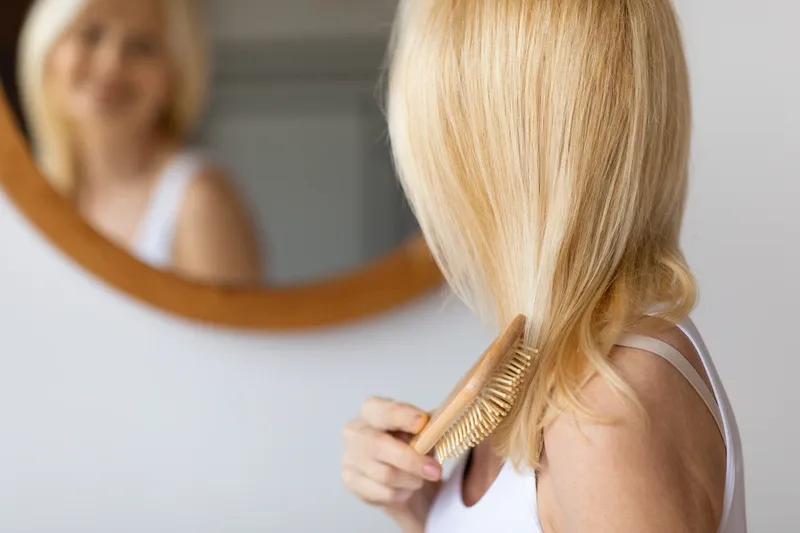Minoxidil is a topical medication used to stimulate hair regrowth in both men and women. It’s available in foam and liquid forms and in varying concentrations. This article will explain how minoxidil works and explore the benefits and potential risks of different dosage levels to help women decide which product may be right for them.
Why Minoxidil Concentration Matters
The U.S. Food and Drug Administration (FDA) has approved lower concentrations of minoxidil for the treatment of androgenetic alopecia, also known as female pattern hair loss (FPHL) in women.(1)(2) Choosing the concentration best suited to each woman’s needs is essential to ensure optimal results while also reducing the risk of potential side effects.

Minoxidil is available in the following dosage strengths:(1)(3)(4)
2% concentration
5% concentration
7% concentration
8% concentration
10% concentration
15% concentration
How Minoxidil Works
Minoxidil works by altering the hair growth cycle. A natural enzyme in the scalp chemically converts the topically applied minoxidil into minoxidil sulfate. Research indicates that minoxidil sulfate is 14 times stronger than minoxidil. It’s this active form of the compound that stimulates hair growth.(1)(5)
Hair growth occurs in four stages:(6)
Anagen phase (hair growth)
Catagen phase (regression)
Telogen phase (rest)
Exogen phase (shedding)
Minoxidil reduces the length of the telogen phase while prolonging the anagen phase. More time spent in the anagen phase allows hair to grow longer and thicker. Minoxidil is also believed to enhance blood flow around the hair follicles, prompting the widening of the arterial blood vessels to support hair growth.(1)
How long does it take for the skin to absorb minoxidil?
The skin absorbs approximately 1.4% of minoxidil. It takes one hour from the time of application for drug uptake to reach 50% and four hours to increase to 75%.(1) It’s important to follow all instructions as outlined on the label. Applying the medication more times than the recommended frequency doesn’t enhance bioavailability.(4)
How long does it take to see results with minoxidil?
Some patients may notice symptom improvement within eight weeks, with the most significant benefits noted after four months of treatment. However, minoxidil is intended for long-term use. Stopping the medication may reduce its effectiveness.(1)
Comparison of Minoxidil Concentrations
Minoxidil in 2% and 5% concentrations can be purchased over the counter (OTC) and are FDA-approved. Compounded formulations containing higher concentrations of the drug may be prescribed off-label.(3)
The following table compares the efficacy and risk of side effects associated with lower and higher concentrations of minoxidil:(7)(8)
Feature | 2% Minoxidil | 5% Minoxidil | 15% Minoxidil |
Efficacy | |||
Effective for Female Pattern Hair Loss? | ✔ Yes | ✔ Yes | ✔ Yes |
More effective than lower concentrations? | N/A | ✔ Yes, may be more effective than 2%. | ✔ Yes, studies suggest it can be more effective, especially for those who didn't respond to 5%. |
An option if 5% is ineffective? | ✖ No | N/A | ✔ Yes |
Risk of Side Effects | |||
Are side effects possible? | ✔ Yes | ✔ Yes | ✔ Yes |
Higher risk than lower concentrations? | N/A | ✔ Yes, may have a greater risk than 2%. | ✔ Potentially, though some studies report no significant increase in adverse effects compared to 5%. |
Regulatory Status | |||
FDA-approved for women? | ✔ Yes, the 2% liquid solution is FDA-approved. | ✔ Yes, the 5% foam is FDA-approved. | ✖ No, this is an off-label strength. |
Available over-the-counter? | ✔ Yes | ✔ Yes | ✖ No |
Prescribed off-label? | ✖ No | ✖ No | ✔ Yes, as a compounded formulation. |
Benefits and Risks of Higher Minoxidil Concentrations
How a patient responds to minoxidil may vary. Some women may have better results with higher concentrations. A study published in the Journal of Biological Regulators and Homeostatic Agents found that 60% of women who did not respond to 5% minoxidil experienced significant improvement in FPHL symptoms after 12 weeks of treatment with 15% minoxidil. No side effects were noted.(8)
Minoxidil Side Effects
Some women may not experience any adverse reactions to the medication. However, some may be more susceptible to the following side effects, with higher concentrations of minoxidil posing a higher risk.(1)(4)
Increased hair shedding
Scalp irritation
Itching
Scaly patches on the scalp
Allergic contact dermatitis
Excessive body hair growth (more commonly associated with oral minoxidil or 5% topical concentrations)
While more often associated with oral minoxidil, there are rare cases in which more severe side effects may occur with topical use, including the following:(1)(4)(9)
Headache
Breathlessness
Weight gain
Low blood pressure
Feelings of a racing heart (palpitations)
An accelerated heart rate of over 100 beats per minute (tachycardia)
Toxicity
Who shouldn’t use minoxidil?
Minoxidil is not intended for individuals under the age of 18 or women who are pregnant or breastfeeding. People with scalp infections, postpartum hair loss, sudden, unexplained hair loss, or those who use other scalp treatment medications should also avoid using minoxidil. It’s also important that women do not use minoxidil solutions intended for men, including products like Rogaine.(1)
How to Choose the Right Strength
It’s recommended that patients start with a lower concentration of minoxidil before increasing the strength. Women starting with 2% liquid minoxidil should apply 1 mL of the solution to the scalp twice a day. Instructions for the 5% foam solution indicate that one-half capful should be applied to the scalp once a day.(1)
If hair loss doesn’t improve with 2% or 5% formulations, consulting a healthcare provider is crucial to assess whether a stronger concentration of minoxidil is recommended. A doctor will consider a patient’s hair loss severity, skin sensitivity, medical history, and medication use to determine if they may benefit from a compounded product.
Lower minoxidil concentrations may not be strong enough for some women to stimulate hair regrowth as desired. On the other hand, higher concentrations of 10% or 15% may increase the risk of side effects. A product that falls in the middle, like a 7% minoxidil serum, may strike a balance between increased effectiveness and a lower risk of side effects. With the guidance of a doctor or dermatologist, women can achieve thicker, fuller, and healthier hair as they age.
